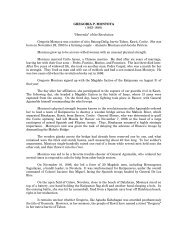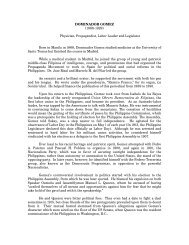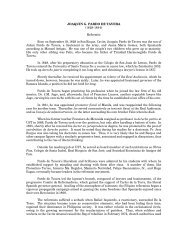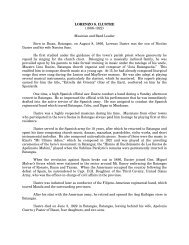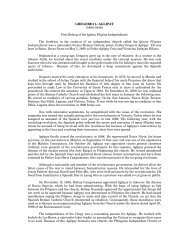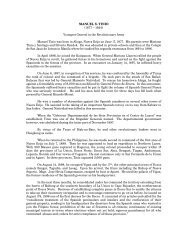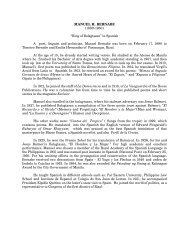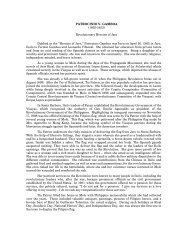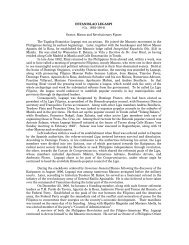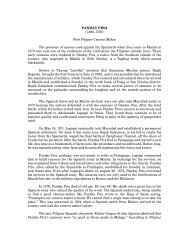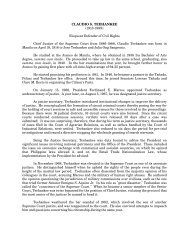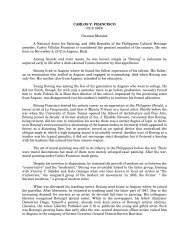HONORATA “ATANG” DE LA RAMA (1902-1991) National Artist ...
HONORATA “ATANG” DE LA RAMA (1902-1991) National Artist ...
HONORATA “ATANG” DE LA RAMA (1902-1991) National Artist ...
Create successful ePaper yourself
Turn your PDF publications into a flip-book with our unique Google optimized e-Paper software.
<strong>HONORATA</strong> <strong>“ATANG”</strong> <strong>DE</strong> <strong>LA</strong> <strong>RAMA</strong><br />
(<strong>1902</strong>-<strong>1991</strong>)<br />
<strong>National</strong> <strong>Artist</strong><br />
Famous during her prime as the “queen of zarzuela and the kundiman,” Honorata<br />
“Atang” de la Rama was born in Pandacan, Manila on January 11, <strong>1902</strong>. Her parents came from<br />
Negros Occidental. During the latter part of her life she lived in Gagalangin, Tondo, birthplace<br />
of her husband, Amado V. Hernandez, himself a <strong>National</strong> <strong>Artist</strong>, whom she married in 1932.<br />
Orphaned at a very young age, she grew up under the care of “an elder sister, who was married<br />
to Leon Ignacio, a zarzuela composer.” At the Ignacio residence, she was constantly exposed to<br />
the zarzuela, for it was where the Hermogenes Ilagan-Leon Ignacio Zarzuela Company often<br />
held their rehearsals.<br />
At fourteen she played Angelita in “Dalagang Bukid,” a zarzuela, in 1917 and popularized<br />
the song “Nabasag ang Banga.” The show was made into a movie in 1919, the first Tagalog fulllength<br />
feature movie. She was so popular in her role as a simple maid turned flirt in “Ang Kiri”<br />
that it was immortalized in the film “Mahiwagang Binibini.”<br />
The first Filipino actress to appear in the movies, de la Rama finished her elementary,<br />
secondary, and college education in Centro Escolar University. A holder of a bachelor of science<br />
in pharmacy degree, she also took up lessons in voice under Victorino Carrion, Nelie Fornerie,<br />
and Tinay Arellano; violin under Leon Ignacio; and piano under Vincenzo Gamberdella. She,<br />
likewise, studied diction with Jovita Fuentes, who later, also became a <strong>National</strong> <strong>Artist</strong>. In 1925,<br />
she went to New York to study at the Royal Dramatic Theater. Back home, with her training in<br />
the theater arts, she began directing dramas and zarzuelas, advising theater groups, and<br />
teaching voice. More important, she became the lead star in around 50 zarzuelas (in various<br />
languages including Spanish and Tagalog) and performed not only in locally-renowned venues<br />
as the Manila Grand Opera House, Manila Hotel, Metropolitan Theater and the teatro Zorilla,<br />
but also in “open plazas” and “cockpits.” De La Rama also sung Kundiman created by some of<br />
the most important composers of the 1920’s and 1930’s. She popularized the songs “Bituing<br />
Marikit,” “Madaling Araw,” “Mutya ng Pasig” and “Anak Dalita.”<br />
She gave public performances not just for a living. Firmly believing that the zarzuela and<br />
the kundiman truly mirrored the Filipino identity she did her best to propagate and popularize<br />
these art forms among the people. She traveled to remote places, to reach even tribal groups<br />
like the Aetas or Negritoes of Zambales and the Sierra Madre in Luzon, and the Bagobos and the<br />
Lumads of Mindanao. She performed before “revolutionary organizations” like the Hukbalahap,<br />
the Sakdal, and the Colorum.<br />
She likewise traveled abroad, propagating the Filipino Kundiman in such places as<br />
Hawaii, San Francisco, Los Angeles, New York, Hong Kong, Shanghai, and Tokyo. She<br />
established her own company called Zarzuela Tagal. She later formed the Samahan ng Bodabil,<br />
an association of Philippine vaudeville performers. She was the mentor of Chichay, an<br />
institution in Philippine entertainment. De La Rama later abandoned vaudeville back to<br />
Zarzuela.<br />
De la Rama also wrote lyrics for songs such as “Pag-asa,” whose music was composed by<br />
L. Ignacio; skits in Spanish, English and Tagalog, including “Hele-Hele,” “Kabayanihan” and<br />
“Milagros ng Birhen,” to name a few; short stories in Tagalog such as “Doon sa Dakong Timog,”<br />
“Sa Malayang Lupain,” “Nakukubling Tala” (under the pseudonym of Herminia de la Riva) and
“Kahinahinayang na Pag-ibig” (under the pen name Matimtimang Laqui) and four operatas,<br />
namely, “Bulaklak sa Kabundukan,” “Aking Ina,” “Anak ni Eva,” “Puri at Buhay.” She starred in<br />
the first full film length Philippine feature film, “Dalagang Bukid” (1919), by Jose Nepomuceno.<br />
Other films she appeared in were “Dugong Silangan” (1930), “Ay Kalisud” (1938), “Batong<br />
Buhay” (1950) and “Ang Buhay at Pag-ibig ni Dr. Jose Rizal.”<br />
During the Japanese occupation, she did her patriotic duty. She carried secret messages,<br />
often hidden in her hairdo, back and forth to Filipino guerillas. When her husband was in<br />
prison, “she smuggled out his poems, and did what part of his work she could do.”<br />
A civic-minded artist, de la Rama led several groups involved not only in culture, but<br />
politics as well, namely the Kaisahan ng Kababaihan sa Pilipinas, the Gagalangin Ladies<br />
Association and the Red Cross Fund drive, and became a zealous supporter of such groups as the<br />
Confederation of Labor Organization, the Home Nursing Association and the Girl Scouts of the<br />
Philippines. Later, she supported various groups like the PETA Babaylan and GABRIE<strong>LA</strong>, by<br />
giving inspiring lectures.<br />
De la Rama gave the best years of her life to the arts. In recognition of her contributions<br />
to the enrichment of the nation’s cultural heritage, the encouragement and the spirit of<br />
excellence in the arts and letters, and for sharing “her talent with the poor,” she was conferred<br />
the <strong>National</strong> <strong>Artist</strong> Award for theater and music on June 11, 1987.<br />
Other awards she received were: Panitik ng Kababaihan (1950), Kababaihan ng Lahi<br />
(1975), Presidential medal of merit (1966), Sagisag ng Lungsod ng Maynila (1964), Diwa ng Lahi<br />
(1974), Reyna ng Kundiman at Mutya ng Dulang Tagalog (1963), Queen of the Kundiman and<br />
Prima Donna of Filipino Theater (1968), Reyna ng Kundiman, Paglilingkod sa Bayan (1973),<br />
Tandang Sora trophy (1977), Walang Kupas Award (1982) and the Ateneo de Manila University<br />
Tanglaw ng Lahi.<br />
On July 11, <strong>1991</strong>, she died of a lingering illness. She was given a state funeral, and buried<br />
at the North Cemetery.<br />
References:<br />
CCP Encyclopedia of Philippine Art Volume 7. Manila: Cultural Center of the Philippines,<br />
1995.<br />
Logarta, Michelle T. “A Portrait of Atang,” Philippine Daily Inquirer, July 18, <strong>1991</strong>.<br />
“Atang De La Rama Dies,” Phil. Daily Inquirer July 12, <strong>1991</strong>.



